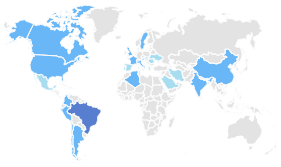The Devil on a Dying Bay: Brazilian Marine Plasticarianism at Guanabara Bay
Resumo
This article provides an overview of the known current situation of Guanabara Bay with respect to its pervasive plastic waste pollution, continuing the paired authors' previous works. In addition, the study opens up a broader public discussion on the fundamentals of global degradation, proposing a review of environmental education curriculums including the correct appropriation of the concept of entropy among adults and young people as well. In this sense, the authors deepen the concept and emphasize the importance of considering it in critical reflections on our present-day and future worldly behaviors and actions. Lastly, the work provides some significant and important relevant data and useful references, tracing some lines of thought for building viable solutions, so that the reader can start or continue further studies on the topic addressed herein.
Key-words: Guanabara Bay, entropy, plastic waste, environmental education, global degradation, consumerism.
======================================================================
O presente artigo fornece um apanhado geral da situação atual da Baía de Guanabara com respeito à poluição por resíduos plásticos, dando continuidade aos trabalhos anteriores dos autores. Além disso, o estudo abre uma ampla discussão sobre os fundamentos da degradação global, propondo uma revisão dos projetos de educação ambiental incluindo a apropriação correta do conceito de entropia por adultos e jovens. Nesse sentido, os autores aprofundam o conceito e ressaltam a importância de considerá-lo nas reflexões críticas sobre os nossos comportamentos e ações. Por último, o trabalho fornece dados e referências relevantes, traçando algumas linhas de pensamento para a construção de soluções viáveis, de modo que o leitor possa iniciar ou prosseguir estudos complementares sobre o tema.
Palavras-chave: Baía de Guanabara, entropia, resíduos plásticos, educação ambiental degradação global, consumismo.
Texto completo:
PDFReferências
Schmidt, C. et al. (June 2017) “River plastic emissions to the world’s ocean” Nature Communications 8: 15611.
Pegalo, T. et al. (2018) “First evidence of microplastic ingestion by fishes from the Amazon. River estuary” Marine Pollution Bulletin 133: 814-821.
Zhao, S. et al. (2020) “Microbial carrying capacity and carbon biomass of plastic marine debris” The ISME Journal: Multidisciplinary Journal of Microbial Ecology. https://doi.org/10.1038/s41396-020-00756-2.
NOTE: “microplastics” was coined by Richard Thompson. SEE: Thompson, R. et al. (7 May 2004) “Lost at Sea: Where Is All the Plastic?” Science 304: 838.
Olivatto, G.P. et al. (February 2018) “Microplastic contamination in surface waters at Guanabara Bay, Rio de Janeiro, Brazil” Marine Pollution Bulletin 139: 157-162.
Neto, J.A.B. et al. (December 2019) “The impact of sediment dumping sites on the concentrations of microplastic in the inner continental shell of Rio de Janeiro” Marine Pollution Bulletin 149: 110558.
Weisman, A. (May-June 2007) “Polymers are forever” Orion 26: 16.
Wright, R.J. et al. (2020) “Marine Plastic Debris: A New Surface for Microbial Colonization’ Environmental Science & Technology54: 11657-11672.
Kubowicz, S. and Booth, A.M. (2017) “Biodegradability of Plastics: Challenges and Misconceptions” Environmental Science & Technology 51: 12058-12060.
Turner, A. et al. (July 2020) “Weathering and persistence of plastic in the marine environment: Lessons from LEGO” Environmental Pollution 262: 114299.
DOI: http://dx.doi.org/10.17648/calibre.v6.1511
Apontamentos
- Não há apontamentos.
Direitos autorais 2021 Nilo Serpa, Richard Cathcart
Indexadores, Diretórios, Bases de Dados e Registros (Abstracted and Indexed in):

CALIBRE - Revista Brasiliense de Engenharia e Física Aplicada
ISSN Eletrônico: 2526-4192































